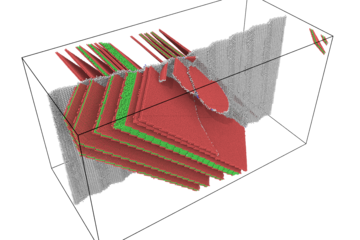All genres
141.
Talk
Multiscale model of strength in single crystal tungsten under uniaxial and biaxial loading. TMS 2015, Orlando, FL, USA (2015)
142.
Talk
Numerically Robust Spectral Methods for Crystal Plasticity Simulations of Heterogeneous Materials. TMS 2015, Orlando, FL, USA (2015)
143.
Talk
Coupled high-resolution experiments and crystal plasticity simulations to analyze stress and strain partitioning in multi-phase alloys. TMS2015, Orlando, FL, USA (2015)
144.
Talk
Experiments on and Simulation of Dual Phase Steel Micromechanics. DGM AK Mikrostrukturmechanik, Kassel, Germany (2015)
145.
Talk
Experimental and Numerical Investigations on Dual Phase Steel Micromechanics. GLADD-Meeting, Leuven, Belgium (2015)
146.
Talk
A Virtual Laboratory to Derive Mechanical Properties. M2i Conference "High Tech Materials: your world - our business"
, Sint Michielgestel, The Netherlands (2014)
147.
Talk
Joint Multiscale simulation and experimental analysis of stress and strain partitioning in dual phase steel. MRS Fall Meeting , Boston, MA, USA (2014)
148.
Talk
Experimental and simulation analysis of dual phase steel micromechanics. Seminar at Departments of Engineering and Materials, Oxford University, Oxford, UK (2014)
149.
Talk
High-strength steels with improved ductility - potentials for lightweight engineering. Jahrestagung STAHL 2014 – Annual Conference of the German Iron Steel Institute, Düsseldorf, Germany (2014)
150.
Talk
The flexible crystal plasticity framework "DAMASK". Jung-DGM Rhein-Ruhr Meeting, Bochum, Germany (2014)
151.
Talk
Ductile damage: Micro-mechanisms, macro-influences. The 4th International Symposium on Steel Science - ISSS 2014, Kyoto, Japan (2014)
152.
Talk
Simulation analysis of stress and strain partitioning in dual phase steel based on real microstructures. MMM2014, 7th International Conference on Multiscale
Materials Modeling
, Berkeley, CA, USA (2014)
153.
Talk
Integrated Experimental-Numerical Methodology for Stress-Strain Mapping Down to Nanoscale. MSE 2014
, Darmstadt, Germany (2014)
154.
Talk
Robust spectral-based numerical methods for heterogeneous microstructures. 4th International Symposium on Computational Mechanics of Polycrystals, CMCn2014, Düsseldorf, Germany (2014)
155.
Talk
Robust spectral-based numerical methods for heterogeneous microstructures. 24th International Workshop on Computational Micromechanics of Materials, IWCMM24, Madrid, Spain (2014)
156.
Talk
Integrated experimental and simulation analysis of stress and strain partitioning in dual phase steel. IUTAM Symposium on Connecting Multiscale Mechanics to Complex Material Design, Evanston, IL, USA (2014)
157.
Talk
Coupled experimental-numerical Analysis of Microstructures. DGM Arbeitskreissitzung Mikrostrukturmechanik, Freiberg, Germany (2014)
158.
Talk
Integrated experimental-numerical methodology to investigate plasticity in bulk nanostructured alloys. DGM Arbeitskreis Sonde, Düsseldorf, Germany (2014)
159.
Talk
Strain and stress partitioning in ultrafine grained ferrite/martensite steel. TMS 2014, San Diego, TX, USA (2014)
160.
Talk
High-Resolution Crystal Plasticity Simulations of Artificial Microstructures. 13th GAMM Seminar on Microstructures, Bochum, Germany (2014)











